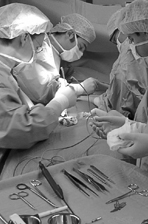Reconstructive Surgery
A so called defect often remains after injuries or the removal of tumours. It is the aim of reconstructive surgery to make good this defect as much as possible. Naturally, miracles cannot be expected, however, treatment has become more refined over the last couple of years, so that we frequently can repair lost functions and also achieve an aesthetically convincing result.
Microsurgery is one major part of reconstructive surgery. Vessels and nerves are prepared under the operating microscope and in this way become accessible for surgery in the first instance as such small nerves and vessels can only be stitched together with the magnification of the microscope. Microsurgical treatment is a major requirement for the reconstruction of the more severe defects of the extremities or after the removal of large tumours. A resulting defect can be closed by transplanting tissue from another part of the body. The latissimus dorsi muscle for example, can be taken from the back together with its vessels and nerves and connected again in another place. Afterwards blood flow and nerves are repaired with the help of the microscope, so that the transplanted tissue with good blood supply can heal well in the new location.
With minor defects it is often enough to simply transplant skin. It is usually taken from the upper thigh and then put on top of the defect. For this it is essential that the wound has healed well and is not infected. Should this not be the case, a so called shifting of tissue from the direct surroundings of the injured or affected area has to be made. Muscles or parts of the subcutaneous tissue can be moved for this, so called flaps.
Reconstructive surgery is very complex. It is important to work out all the different options to close defects with you and find the way that offers the best functioning and aesthetic appearance.




